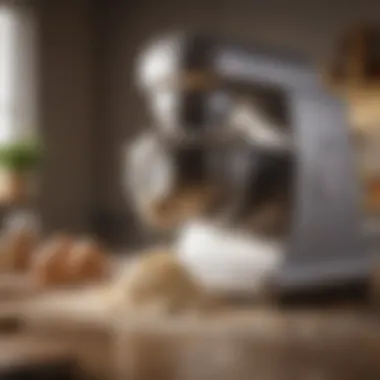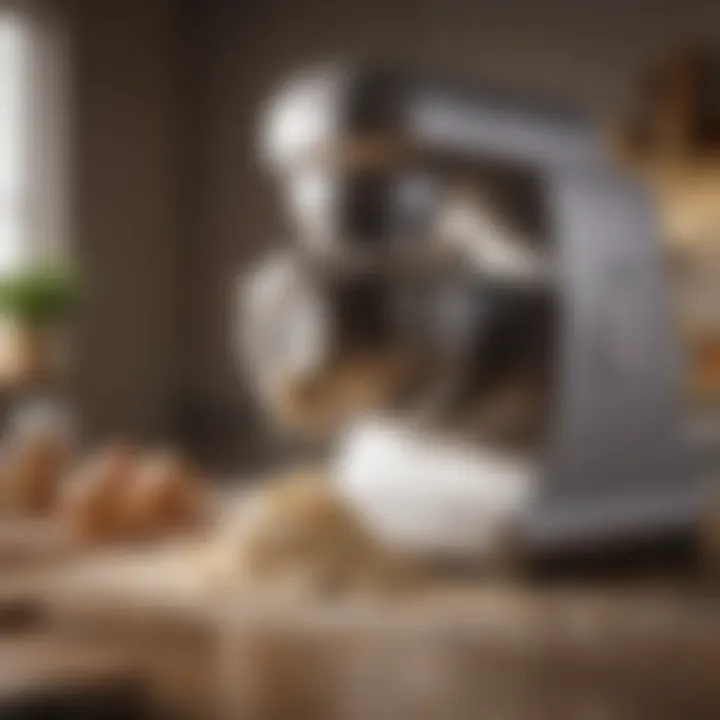Exploring the Versatile Dough Kneading Machine


Intro
In the ever-evolving world of culinary arts, dough kneading machines have made their way into both home kitchens and commercial bakeries, changing the way we prepare dough. These machines are not just a luxury but a necessity for many, paving the path to perfect bread, pizza, and pastries. Understanding the intricacies of these machines can enhance any chef's repertoire. Whether you are an amateur baker or a seasoned professional, knowing how to efficiently knead dough using these versatile devices opens up a world of opportunities in the kitchen.
Each dough kneading machine brings with it a unique set of features and functions that can cater to various types of culinary needs. With the right knowledge, one can unlock the full potential of these machines, leading to improved dough texture and flavor. So, let's roll up our sleeves and delve into the mechanics, benefits, and practical applications of these incredible machines.
Intro to Dough Kneading Machines
In the universe of baking, the dough kneading machine stands out as a pivotal tool, bridging the gap between traditional methods and modern efficiency. These machines have not just changed the way dough is prepared, but they have also transformed kitchens into arenas of creativity and precision. For those who fancy themselves as culinary enthusiasts, understanding the importance and functionality of these machines is essential.
Why do bakers today turn to machines instead of relying solely on their own strength and skill? Well, the key benefits are clear. Firstly, dough kneading machines save time—a precious commodity in our fast-paced world. With the ability to mix and knead large batches of dough quickly, they free up time for other tasks in the kitchen, such as preparing fillings or setting the table.
Moreover, the consistency offered by these machines is noteworthy. Each batch of dough can be kneaded to the exact specifications, ensuring that your bread, pizza, or pastries come out just right every time.
Not to mention, for those with physical limitations or who simply want to avoid the repetitive strain of hand kneading, they offer a significant reduction in the physical labor required. It’s a modern solution that marries technology with culinary passion.
"A good dough kneading machine is like a reliable friend in the kitchen—always there to support you when the going gets tough."
To really appreciate the value of dough kneading machines, we should first delve into their past, outlining their journey from crude, manual methods to sophisticated gadgets that modern kitchens can't do without.
Historical Overview
Dough kneading as a practice has a rich history that dates back thousands of years. Initially, everything was done by hand. Early bakers relied on their arms and sheer determination to develop gluten—an essential component for elastic bread dough. While it’s charming to think about the way our ancestors crafted bread, hand kneading is a labor-intensive endeavor that leaves even the toughest bakers feeling fatigued.
The first significant change came in the 19th century when specialized machines began to emerge. These were more than mere labor-saving devices; they marked the beginning of an industrial revolution in bakeries across Europe. Their invention coincided with increased urbanization and the rise of large bakeries meant to cater to bustling cities.
The Evolution of Dough Kneading Technology
Fast forward to today, and the evolution of dough kneading technology is nothing short of remarkable. Early machines were basic, often prone to breakdowns and requiring a good bit of strength to operate. However, modern models are a far cry from their ancestors.
Today’s dough kneading machines come equipped with an array of features designed to enhance the user experience. From programmable settings that allow for specific kneading times and speeds to advanced motors that adjust automatically based on dough texture, we live in an era where baking can feel more like an art form than a chore.
Here’s a brief rundown of some technological advancements:
- Variable speed controls that let users tailor the kneading process.
- Timer functions to prevent over-kneading.
- Interlocking safety features that ensure safe operation.
In essence, as we’ve moved through the ages, the dough kneading machine has adapted to fit the needs of both home bakers and culinary professionals, enhancing not just the process of making dough, but also the craft of baking itself.
Understanding the Mechanics
Understanding how dough kneading machines work is more than just a technical overview; it plays a crucial role in enhancing cooking experiences for both the home baker and professional chef. Grasping the mechanics behind these machines helps users to select the right model for their needs and usage. When you comprehend the inner workings of a kneading device, it empowers you to make informed choices, leading to consistent results and improvements in the quality of your baked goods.
How Dough Kneading Machines Work
Dough kneading machines function on the principle of mechanical energy transforming into motion, which in turn affects the dough. At its core, these machines use motors, belts, and a variety of attachments designed specifically for the kneading process. This intricate dance of machinery creates the perfect amount of elasticity and gluten development necessary for bread, pizza, and pastries.
For anyone diving into the world of baking, knowing how dough kneading machines operate can demystify a portion of the process that once depended heavily on sheer physical effort.
Key Components of Dough Kneaders
The richness of the dough kneading experience lies significantly in the various components of these machines. Understanding each part helps users appreciate their value and identify any potential problems.
Motor Functionality
The motor in a dough kneader is essentially its powerhouse. Motors come in different sizes and types—some heavy-duty while others are more suited for light tasks. A robust motor contributes to the machine's ability to handle various dough consistencies, from thick bagel mixtures to soft pastry doughs.
One distinctive aspect of motor functionality is the wattage—higher wattage typically indicates a stronger motor capable of executing more demanding tasks. Thus, for serious bakers, a machine equipped with a powerful motor becomes a worthwhile investment. However, one should note that high wattage often leads to increased energy consumption, which might not be ideal for everyone.
Kneading Blades
Kneading blades are another vital element of dough kneaders. Depending on the design, they can resemble hooks, paddles, or even spiral shapes. Each blade offers unique benefits depending on its purpose, making it essential to choose the right one matched to the dough type.
For instance, spiral blades are favored for their efficiency in incorporating air into the dough, which can enhance rise and texture. The downside, however, may be their tendency to slightly over-knead sensitive mixtures, leading to tough textures. Knowing which blade to use and when can drastically improve your dough making.
Control Panels
Control panels in these machines are where functionality meets user experience. They often come equipped with various settings that can adapt the kneading speed and time, giving users full control over their dough preparation.


Modern control panels may include digital displays, timers, and even memory settings to save favorite kneading profiles. This functionality is a godsend for those who juggle multiple tasks in the kitchen. On the flip side, though, more intricate panels can be intimidating for beginners, often discouraging them from fully utilizing their machines.
In summary, understanding how dough kneading machines operate and the roles of key components like motors, blades, and control panels plays an essential part in maximizing your baking endeavors.
Types of Dough Kneading Machines
When it comes to creating the perfect dough, the tools you choose can make all the difference. Dough kneading machines are a category that’s worth exploring in depth. From home bakers whipping up a batch of cookies to professional chefs crafting artisan bread, having the right type of kneading machine can impact consistency, efficiency, and the overall quality of the final product. Understanding each type allows culinary enthusiasts to choose a machine that suits their needs, whether they're making a small loaf of bread or prepping dough for an entire bakery's worth of pastries.
Stand Mixers
Stand mixers are the workhorses in many kitchens. The luminous KitchenAid Stand Mixer is perhaps the most well-known, but there are various brands that provide high-quality alternatives. These mixers generally come with a mixing bowl that locks into place and a range of attachments, including dough hooks that specialize in kneading.
The advantages of stand mixers include versatility. You can whip cream, mix batter, and knead dough, all with one device. This makes it a valuable asset for individuals who enjoy baking but can't justify purchasing multiple appliances. More so, the larger capacities make them suitable for scaling recipes without breaking a sweat.
However, potential buyers need to consider the weight and space they will require in their kitchen. These machines can be heavy-duty, and some kitchen countertops may not support their weight. Additionally, while they can knead for a longer time, there might be limitations depending on the specific model regarding how well they incorporate gluten without overworking the dough.
Kneading Machines vs. Hand Kneading
At the heart of the kneading debate lies whether to choose a machine or stick to the age-old method of hand kneading. Hand kneading is an art form in its own right, allowing the baker to engage directly with the dough, feeling its texture and adjusting as necessary. Many home bakers argue that hand kneading grants superior control over the dough's hydration levels and gluten development.
On the other hand, machines like the Bosch Universal Kitchen Machine can take the strain off your arms and save valuable time. They can knead dough within minutes compared to the manual process, which can take upwards of 10 to 15 minutes of laborious effort.
Here are some considerations between the two:
- Hands-On Experience:
- Machine Efficiency:
- Pros: Engages the baker, teaches technique, and fosters a connection with the ingredients.
- Cons: Physically demanding and time-consuming.
- Pros: Saves time, perfect for larger batches, and can handle tougher dough.
- Cons: Lacks the personal touch and requires upfront investment.
Commercial Dough Kneaders
For those working in the culinary field, there are specialized machines designed to handle large quantities of dough, such as commercial kneaders. These machines, like the Hakko Dough Mixer, are built from robust materials to withstand continuous use in busy bakeshops. They often feature advanced technology that allows precise control over mixing times, kneading speeds, and even temperature control, contributing to consistent dough quality.
Commercial kneaders are usually more costly, but they are designed to deliver optimal results at a faster rate, making them indispensable for businesses. They can also help reduce physical strain for employees who might otherwise spend long hours kneading by hand. However, ownership of such machines often comes with considerations regarding space and energy consumption, making it crucial to weigh the pros and cons based on your operational needs.
In summary, understanding the various types of dough kneading machines is essential for choosing the right one for your culinary endeavors. Each type has unique features, advantages, and challenges. By making an informed decision, you can ensure that your dough comes out just right, every time.
Benefits of Using a Dough Kneading Machine
When it comes to baking, there are a bunch of factors that can make or break the final outcome. One of the game changers in this domain is, without a doubt, the dough kneading machine. It’s not just a gadget that sits on your counter; it’s a silent partner in the kitchen that can enhance your baking experience in several unmistakable ways. Let’s dive into the core reasons that make these machines a must-have for any serious culinary enthusiast.
Efficiency and Time-Saving
Time, as they say, is money, and in the world of baking, it can also mean a world of difference. When you use a dough kneading machine, the efficiency shoots up faster than a soufflé in the oven. Unlike hand kneading, which can become a lengthy chore—trust me, the muscle ache is real—these machines whip through the process in a fraction of the time. Imagine the luxury of spending just fifteen minutes to knead a batch of dough instead of laboring for thirty or even forty, leaving you with more time to focus on other culinary pursuits.
Not only do these machines save time, but they also allow you to multi-task effectively. While the machine does its magic, you can prep other ingredients or clean up the kitchen. Think about it; less mess and more productivity. With today’s fast-paced lifestyle, being able to quickly combine ingredients means you can whip up fresh bread, pizzas, or pastries almost on a whim, making it a perfect fit for anyone juggling work, family, and, let’s not forget, personal time.
Consistency in Dough Quality
Have you ever baked a loaf of bread that turned out less than stellar? Perhaps the dough was too sticky, or maybe, it didn't rise properly. With a dough kneading machine, these mishaps can become a thing of the past. The machine offers consistent mixing speeds and kneading times, ensuring that each batch of dough comes out just the way it should; smooth and elastic.
The science behind kneading is key to developing gluten, which gives bread and pastries their structure. A machine guarantees that the dough is worked sufficiently—every time.
When you knead by hand, there’s variability in how much effort and time you can put into each batch. This inconsistency can lead to unpredictable results in your baking. With a machine, you can repeat successful recipes and achieve the same outcome over and over again, creating reliable quality that’s critical for commercial bakers and aspiring professionals alike.
Reduction of Physical Labor
Let’s get real; kneading dough is hard work. It’s a labor-intensive process that requires arm strength, stamina, and sometimes involves wrestling with sticky or heavy mixtures. The beauty of a dough kneading machine is it lightens this load considerably. With just the press of a button, you are spared from the wear and tear that comes with hand kneading.
This aspect is especially appealing to those who may have physical limitations or simply don’t want to break a sweat in the kitchen. A machine takes away the grueling aspect of dough preparation, allowing for a more enjoyable and less strenuous baking experience. Plus, it opens the door for younger bakers or those who may find intensive labor daunting, fostering a new generation of culinary enthusiasts eager to explore the art of baking.
In sum, the benefits of using a dough kneading machine are evident. They save time, provide consistent results, and lighten physical strain. Together, these advantages make the experience of baking not only more enjoyable but also significantly more efficient.
Practical Applications in the Kitchen
Dough kneading machines have redefined culinary practices in the home and commercial environments. Embracing these machines is akin to welcoming a new member into the kitchen—one that not only saves time but enhances quality and consistency. Their practical applications span across various types of dough that are staples in both everyday cooking and special occasions.
Making Bread


Making bread is often considered an art form, though it can quickly turn into a laborious task. With a dough kneading machine, the process becomes straightforward and efficient. The machine takes on the rigorous physical demands that come with kneading, allowing bakers to focus on other vital tasks such as selecting ingredients and shaping the loaf.
The benefits of using a machine for bread-making include:
- Consistent Texture: Machines provide even and thorough kneading, leading to a uniform texture.
- Reduced Effort: No more sore arms after an intense kneading session. The machine does the hard work.
- Perfect Timing: These machines often come with timers, ensuring that your dough is kneaded for just the right amount of time.
Moreover, bakers can experiment with various bread recipes—be it whole grain, sourdough, or enriched bread—confident in the quality the machine will help produce.
Pizza Dough Preparation
Home pizza nights can evolve from a simple meal into a culinary experience with the aid of dough kneading machines. Pizza dough requires specific handling; too much or too little kneading can impact the final product. Involving a machine allows for the precise development of gluten, which is crucial for that chewy, delightful crust.
- Speed: When hosting, there’s no time to waste. These machines can whip up the dough in minutes.
- Flexibility for Varieties: Whether you're whipping up thin crust, deep-dish, or Neapolitan-style dough, the machine easily adapts.
- Ease of Preparation: All you need to do is toss the ingredients in, switch on the machine, and let it handle the task.
Having a perfectly kneaded pizza dough opens avenues for creativity, allowing pizza enthusiasts to craft signature pies right at home.
Pastries and Beyond
Pastries require a delicate balance of ingredients and handling. The versatility of dough kneading machines shines here as well. From flaky pie crusts to buttery croissants, the machines tackle all the nuances of dough preparation that may have daunted even seasoned bakers.
- Precision: Exact kneading and mixing stir up the right amount of air needed for flakiness without overworking the dough.
- Variety of Dough Types: These machines aren't just for bread. They skillfully help prepare choux, brioche, or puff pastry.
- Less Mess: A cleaner work surface is a welcome by-product; no more flour explosions and sticky hands.
Integrating a dough kneading machine into the kitchen for making pastries or any other types of dough proves beneficial, as the culinary experience becomes more rewarding and less taxing.
"Dough kneading machines not only enhance the quality of baking but also transform the experience, making it accessible to everyone, regardless of skill level."
In summary, these machines cater to various culinary needs, serving as indispensable tools in the kitchen. They enable home and professional chefs alike to create exceptional food while fostering creativity and reducing labor.
Maintaining Your Dough Kneading Machine
Maintaining your dough kneading machine is paramount for ensuring its longevity and performance. Just like any intricate piece of culinary equipment, the kneader relies on regular upkeep to function at its best. Not only does this practice extend the machine's life, but it also safeguards the quality of the dough produced. After all, a well-maintained machine creates the foundation for remarkable bread, pastries, and other baked goods.
The importance of routine care cannot be overstated. A neglected machine can lead to subpar results—lumpy dough, inconsistent textures, and even failure to knead properly. Additionally, dirt and residue can accumulate, affecting the overall hygiene, which is crucial in any kitchen setting. So, taking the time to maintain this versatile machine translates to more than just preserving the gadgets; it’s about ensuring your culinary endeavors don't go awry.
Regular Cleaning Procedures
Cleaning your dough kneading machine should be viewed as an essential ritual. A clean machine not only looks good but works wonders on the final product. Here's a simple step-by-step approach to effective cleaning:
- Unplug the Machine: Safety first! Always ensure the machine is disconnected from the power supply before cleaning.
- Dismantle Components: Carefully remove the mixing bowl and kneading blades. Most models allow easy detachment for thorough cleaning.
- Hand Wash: Using warm, soapy water, gently scrub the components using a soft sponge to avoid scratches. Pay close attention to any areas that may trap dough particles.
- Avoid Harsh Chemicals: Use mild dish soap as strong cleaning agents can damage the materials. It's easy to forget that some elements can be sensitive to certain chemicals.
- Rinse and Dry: After washing, rinse thoroughly with clean water and allow to air dry completely before reassembling.
Adhering to this routine will go a long way in keeping your machine in top shape. It’s worth noting that some manufacturers recommend specific cleaning practices; check the user manual for tailored guidance.
Troubleshooting Common Issues
Even the best machines can run into a snag from time to time. To circumvent potential baking catastrophes, being able to troubleshoot common problems is beneficial. Here’s a rundown of frequent issues you might encounter and how to address them:
- Dough Sticking to the Bowl: If you find your dough clinging like a toddler to their favorite toy, it might be too wet or the bowl isn’t lubricated well. Adding a sprinkle of flour can often do the trick, or apply a light coat of oil before mixing.
- Inconsistent Kneading: If the kneader gives you more of a 'gentle massage' than the thorough kneading you desire, check if the speed settings are appropriately adjusted or if ingredients are unevenly distributed.
- Overheating: Machines can overheat during extended use. If it feels excessively hot, it’s possibly working too hard or needs a break. Turn it off and let it cool down before attempting to use it again.
In the world of culinary delights, having a reliable kneading machine makes life a whole lot easier. By keeping it clean and being aware of how to troubleshoot issues, you set the stage for perfect dough each time. As the old saying goes, "A stitch in time saves nine"—in this case, a little maintenance can save you a whole lot of trouble later.
Popular Models in the Market
When delving into the world of dough kneading machines, recognizing the popular models available holds significant weight. These machines vary broadly in features, capabilities, and use-cases, catering to different needs. Whether you’re a home baker who whips up a loaf on weekends or a commercial entity making hundreds of pizzas daily, knowing the right model can greatly affect your baking experience.
Top Stand Mixers for Home Use
For those who enjoy baking at home, certain stand mixers stand out for their versatility and performance. These machines combine power with user-friendly designs, extending their functionality beyond just kneading.
- KitchenAid Artisan Series: A quintessential choice, this stand mixer comes with a robust 325-watt motor and a 5-quart bowl, perfectly suited for modest family batches. Its attachments and sleek design allow for a variety of culinary tasks. The tilt-head design makes it easy to access the bowl, and its broad selection of attachments enhances its value.
- Bosch Universal Plus: Known for its impressive power, this model features a unique bowl design allowing for thorough mixing of larger quantities. The 800-watt motor and adjustable speed settings contribute to its efficiency. The dough hooks are particularly noteworthy, handling heavier dough with ease.
- Sunbeam MixMaster: Although often overlooked, this stand mixer offers great value. It's budget-friendly and features a 350-watt motor, making it ideal for someone just starting their baking journey. Its classic design and convenient manual controls speak a language of simplicity and function.
These machines reflect a blend of durability, power, and functionality. When selecting a model, consider not only your baking habits but also the attachments and extras that come along with it, as they can enrich your culinary activities.
Heavy-Duty Commercial Options
For professional bakers or those in the food-service industry, heavy-duty commercial kneading machines are crucial. These machines often bring a level of robustness that stands up to rigorous, repeated use.
- Hobart N50: A veteran in the game, the Hobart model offers a 5-quart capacity and an extremely reliable motor. This machine is often found in delis and bakeries because it is tough enough to handle large batches without breaking a sweat. Its planetary mixing action ensures even kneading, making it an excellent choice for dough.
- Viking Professional Stand Mixer: This model doesn’t shy away from hefty tasks and has a 3.5 horsepower motor designed to keep up with the demands of a busy kitchen. It features a family-sized bowl and a variety of attachments tailored for commercial use.
- Globe SP16: Specifically geared towards heavy-duty operations, this planetarium mixer is built to handle pizza dough and bread without losing momentum. Its three-speed settings make it a favorite among those who need precise control over mixing.
Making an informed choice about baking equipment allows you to maximize your efficiency and align your tools with your baking aspirations, whether for home cooking or for a busy, bustling kitchen. Each of these models brings something unique to the table, ensuring that even the most discerning baker can find a fitting partner for their culinary pursuits.


The Impact of Dough Kneading Machines on Culinary Practices
Dough kneading machines are more than just gadgets in the kitchen; they serve as pivotal instruments that bridge the gap between age-old culinary traditions and the fast-paced demands of modern cooking. They empower both amateur cooks and seasoned chefs alike to explore the art of baking without the wear and tear of traditional kneading methods. As the world of cooking continues to evolve, the importance of these machines becomes ever more apparent.
With the rise of food culture on social media platforms and cooking shows, there’s a resurgence in the public's interest in homemade goods. Dough kneading machines play a vital role in this trend, making it feasible for anyone to replicate professional-quality results at home. They automate the physical aspects of kneading, decreasing the time required to achieve the perfect dough texture. This not only invites more home cooks into the fray but also elevates the standard of home-baked goods, a win-win for culinary enthusiasts.
Integrating Technology with Tradition
The synergy between technology and tradition is evident when observing how dough kneading machines are utilized in kitchens. Traditionally, dough was kneaded by hand, demanding not just skill but also considerable strength and time. The introduction of machines, like those by KitchenAid or Kenwood, has changed this landscape considerably.
With a dough kneader, even the most novice cook can produce dough that rivals that of seasoned bakers. This democratization of cooking allows for more creativity in the kitchen. It encourages individuals to experiment with different types of doughs, expanding their culinary repertoire. Not only does the machine knead the dough effectively, it's also designed to make the process simple and accessible, allowing the cook to focus on trialing new recipes without the fatigue of manual kneading.
"In our fast-paced world, it is vital to embrace tools that enhance our cooking experiences without losing the essence of traditional methods."
Adapting to Modern Cooking Needs
In today's kitchens, the demands and expectations surrounding cooking have changed significantly. People want efficiency without sacrificing quality. Dough kneading machines have stepped up to meet these modern needs by offering a variety of settings that allow cooks to adjust for different dough types.
For instance, machines designed for high-gluten bread can have distinct kneading cycles, while those meant for pastry dough will have softer mixing approaches. This adaptability means that whether you are crafting a artisan loaf or a delicate pastry, there is a machine equipped to handle the job effectively.
Moreover, more recent models are incorporating smart technology. These features offer users the ability to connect their machines with apps, providing step-by-step guidance through the mixing and kneading processes. This integration reflects an understanding of modern cooking habits—where busy lifestyles often prohibit spending hours in the kitchen.
Having a reliable dough kneading machine on hand isn't just about convenience; it can nurture a deeper appreciation for baking. By simplifying processes, these machines allow cooks to engage more fully with the creative aspects of recipe development, rather than becoming bogged down in physical methods.
In summary, the impact of dough kneading machines on culinary practices lies not just in their ability to make dough more easily but in their capacity to inspire. They elevate the baking experience, merging age-old techniques with contemporary convenience and creativity.
Future Trends in Dough Kneading Technology
As we look into the future of culinary technology, dough kneading machines are poised for some remarkable advancements. These machines are not just about mixing flour and water; they represent a blend of art and science, a way to elevate baking from mere routine to a sophisticated process. Understanding the trends that lie ahead is crucial for culinary enthusiasts, whether they are home cooks or professional chefs.
The significance of exploring future trends in dough kneading technology cannot be overstated. With innovations continually reshaping our kitchens, these machines are becoming increasingly user-friendly, efficient, and environmentally sustainable. Key areas to consider include smart automation and sustainability—two vital elements that promise to redefine how we think about food preparation in the years to come.
Smart Machines and Automation
The rise of smart technology is influencing every aspect of our lives, including the kitchen. Nowadays, we’re starting to see dough kneading machines equipped with smart features—imagine being able to control your kneader from a smartphone, scheduling it to start exactly when you want.
Such smart machines often come with built-in sensors that can detect dough texture, moisture levels, and other critical parameters. For instance, a sensor might let the machines know when the dough has reached the optimal elasticity for perfect bread. This kind of feedback can lead to better outcomes consistently, reducing the guesswork that often comes with baking.
Not only that, but automated programs tailored to specific types of bread or pastries save time and don’t require much oversight. You could theoretically set it and forget it, allowing for multitasking in the kitchen. Think about it—while your machine is busy kneading your dough, you could be prepping other ingredients or simply relaxing.
"The integration of smart technology in dough kneading machines transforms the ordinary into the extraordinary, giving home bakers tools that were once the exclusive domain of professionals."
Moreover, with future software updates, machines might even learn your preferences over time, adjusting settings to accommodate your unique baking style. This adaptation reflects a larger trend of personalized cooking experiences made possible by technology.
Sustainability in Kitchen Appliances
In today’s world, sustainability is a buzzword that resonates deeply with consumers, and it’s increasingly becoming a priority in appliance design. Dough kneading machines are no exception. Manufacturers are now recognizing that eco-friendliness is not just a trend; it is essential for the future.
Sustainable practices might include using energy-efficient motors that require less electricity or materials that are recyclable. For example, some new models are being designed with lower energy consumption rates, which makes them more appealing to environmentally-conscious consumers.
Additionally, there’s a focus on durability and longevity of products. A well-made dough kneading machine that lasts for years is inherently more sustainable than a cheaper alternative that has to be replaced frequently. Therefore, investing in higher-quality machines encourages a more sustainable kitchen.
As communities become more aware of their environmental impact, future trends in dough kneading technology will likely emphasize not just performance, but also the ecological footprint. In this regard, assessing energy efficiency ratings or the materials used in the construction of these machines can significantly inform purchasing decisions.
In summary, the future of dough kneading technology is brightly lit with innovation and sustainability. Smart machines are set to lead the charge with their automated capabilities, while an emphasis on eco-friendly practices ensures that baking stays relevant—not just tasty but also responsible.
Whether you are an aspiring chef or a seasoned baker, keeping an eye on these trends may help you adapt to and embrace the changes coming to your kitchen.
Ending
The conclusion of our exploration into dough kneading machines highlights not only their importance in the kitchen but also the broader implications for both home cooks and professionals alike. Understanding how these machines work, and the variety of their applications can greatly enhance culinary experiences. In the fast-paced world we live in today, time efficiency and consistent results are critical elements for successful cooking and baking.
Benefits of Dough Kneading Machines
Utilizing a dough kneading machine can transform the way one approaches cooking. These machines free up time, allowing bakers to focus on creativity and refinement rather than expending energy on manual labor. With a kneading machine, the dough receives a consistent, thorough knead which is essential for achieving the perfect crumb in bread or the right texture in pastries.
"Given that consistency is the key to culinary success, these machines promise uniform quality every time, meeting the demands of both seasoned bakers and amateurs."
Final Considerations
As culinary technology advances, so too does the potential for these machines to integrate smart technology. The rise of smart appliances indicates that the future will likely see more automated, user-friendly options. For instance, apps that allow remote control or customization of kneading cycles can cater to individual preferences, changing the landscape of home baking.
Moreover, maintaining these machines with regular cleaning and attention to common troubleshooting can prolong their lifespan, ensuring they remain a reliable partner in the kitchen for years to come.
In summary, understanding and embracing dough kneading machines not only improves efficiency but also elevates the artistry of baking. By integrating these versatile tools, bakers can focus on innovation and creativity, unlocking new possibilities in the culinary realm.







